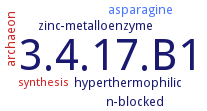3.4.17.B1: Sulfolobus solfataricus carboxypeptidase
This is an abbreviated version!
For detailed information about Sulfolobus solfataricus carboxypeptidase, go to the full flat file.

Word Map on EC 3.4.17.B1 
-
3.4.17.B1
-
hyperthermophilic
-
zinc-metalloenzyme
-
n-blocked
-
asparagine
-
archaeon
-
synthesis
- 3.4.17.B1
-
hyperthermophilic
-
zinc-metalloenzyme
-
n-blocked
- asparagine
- archaeon
- synthesis
Reaction
Release of basic, acidic and aromatic amino acids from the respective benzoylglycated and benzyloxycarbonylated amino acids. Slow hydrolysis of aliphatic amino acids. No activity with benzyloxycarbonyl-Pro and benzyloxycarbonyl-Trp =
Synonyms
carboxypeptidase, carboxypeptidase S1, CPS, cpsA, CPSso, M20.008, SSO1355, thermostable carboxypeptidase 1
ECTree
Advanced search results
General Stability
General Stability on EC 3.4.17.B1 - Sulfolobus solfataricus carboxypeptidase
Please wait a moment until all data is loaded. This message will disappear when all data is loaded.
13% remaining activity in 0.1% SDS at 70°C after 180 min, stable at 40°C
after dilution of the carboxypeptidase in MES buffer, pH 6.5, in the absence of glycerol and 2-mercaptoethanol, the enzyme undergoes a slow loss of activity
immobilization of the enzyme on magnetic nanoparticles improves long-term stability at room temperature compared to the free native enzyme and also results in a significantly higher stability in organic solvents at 40°C
in the absence of glycerol and beta-mercaptoethanol, at 50°C, the enzyme undergoes a slow thermal inactivation upon dilution in an aqueous buffer at pH 6.5. This loss of activity can be inhibited when the enzyme is maintained at high pressure. At higher temperatures, higher pressures (up to 400 MPa) are required to maintain the enzyme in its active state.
inactivation is strongly temperature and pressure dependent


 results (
results ( results (
results ( top
top





